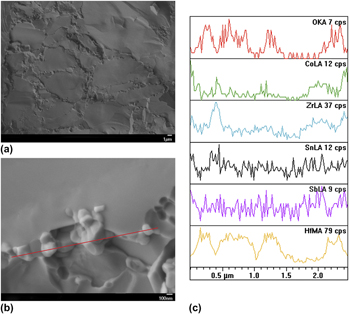Crossref Citations
This article has been cited by the following publications. This list is generated based on data provided by
Crossref.
Xie, Wenjie
Weidenkaff, Anke
Tang, Xinfeng
Zhang, Qingjie
Poon, Joseph
and
Tritt, Terry
2012.
Recent Advances in Nanostructured Thermoelectric Half-Heusler Compounds.
Nanomaterials,
Vol. 2,
Issue. 4,
p.
379.
Kirkham, Melanie J.
dos Santos, Antonio M.
Rawn, Claudia J.
Lara-Curzio, Edgar
Sharp, Jeff W.
and
Thompson, Alan J.
2012.
Abinitiodetermination of crystal structures of the thermoelectric material MgAgSb.
Physical Review B,
Vol. 85,
Issue. 14,
Douglas, Jason E.
Birkel, Christina S.
Miao, Mao-Sheng
Torbet, Chris J.
Stucky, Galen D.
Pollock, Tresa M.
and
Seshadri, Ram
2012.
Enhanced thermoelectric properties of bulk TiNiSn via formation of a TiNi2Sn second phase.
Applied Physics Letters,
Vol. 101,
Issue. 18,
Wang Chai, Yaw
and
Kimura, Yoshisato
2012.
Nanosized precipitates in half-Heusler TiNiSn alloy.
Applied Physics Letters,
Vol. 100,
Issue. 3,
Poon, S. J.
and
Petersen, A. S.
2012.
Effective medium approach to thermal conductivity: applying to core-shell nanocomposites.
Emerging Materials Research,
Vol. 1,
Issue. 6,
p.
286.
Chai, Yaw Wang
and
Kimura, Yoshisato
2013.
Microstructure evolution of nanoprecipitates in half-Heusler TiNiSn alloys.
Acta Materialia,
Vol. 61,
Issue. 18,
p.
6684.
Birkel, Christina S.
Douglas, Jason E.
Lettiere, Bethany R.
Seward, Gareth
Verma, Nisha
Zhang, Yichi
Pollock, Tresa M.
Seshadri, Ram
and
Stucky, Galen D.
2013.
Improving the thermoelectric properties of half-Heusler TiNiSn through inclusion of a second full-Heusler phase: microwave preparation and spark plasma sintering of TiNi1+xSn.
Physical Chemistry Chemical Physics,
Vol. 15,
Issue. 18,
p.
6990.
Joshi, Giri
Dahal, Tulashi
Chen, Shuo
Wang, Hengzhi
Shiomi, Junichiro
Chen, Gang
and
Ren, Zhifeng
2013.
Enhancement of thermoelectric figure-of-merit at low temperatures by titanium substitution for hafnium in n-type half-Heuslers Hf0.75−Ti Zr0.25NiSn0.99Sb0.01.
Nano Energy,
Vol. 2,
Issue. 1,
p.
82.
Populoh, Sascha
Brunko, Oliver
Gałązka, Krzysztof
Xie, Wenjie
and
Weidenkaff, Anke
2013.
Half-Heusler (TiZrHf)NiSn Unileg Module with High Powder Density.
Materials,
Vol. 6,
Issue. 4,
p.
1326.
Chen, Shuo
Lukas, Kevin C.
Liu, Weishu
Opeil, Cyril P.
Chen, Gang
and
Ren, Zhifeng
2013.
Effect of Hf Concentration on Thermoelectric Properties of Nanostructured N‐Type Half‐Heusler Materials HfxZr1–xNiSn0.99Sb0.01.
Advanced Energy Materials,
Vol. 3,
Issue. 9,
p.
1210.
Ma, Yi
Heijl, Richard
and
Palmqvist, Anders E. C.
2013.
Composite thermoelectric materials with embedded nanoparticles.
Journal of Materials Science,
Vol. 48,
Issue. 7,
p.
2767.
Chen, Shuo
and
Ren, Zhifeng
2013.
Recent progress of half-Heusler for moderate temperature thermoelectric applications.
Materials Today,
Vol. 16,
Issue. 10,
p.
387.
Xie, Wenjie
Wang, Shanyu
Zhu, Song
He, Jian
Tang, Xinfeng
Zhang, Qingjie
and
Tritt, Terry M.
2013.
High performance Bi2Te3 nanocomposites prepared by single-element-melt-spinning spark-plasma sintering.
Journal of Materials Science,
Vol. 48,
Issue. 7,
p.
2745.
Makongo, Julien P.A.
Zhou, Xiaoyuan
Misra, Dinesh K.
Uher, Ctirad
and
Poudeu, Pierre F.P.
2013.
Correlation between processing conditions, microstructure and charge transport in half-Heusler alloys.
Journal of Solid State Chemistry,
Vol. 201,
Issue. ,
p.
280.
Fu, Chenguang
Zhu, Tiejun
Pei, Yanzhong
Xie, Hanhui
Wang, Heng
Snyder, G. Jeffrey
Liu, Yong
Liu, Yintu
and
Zhao, Xinbing
2014.
High Band Degeneracy Contributes to High Thermoelectric Performance in p‐Type Half‐Heusler Compounds.
Advanced Energy Materials,
Vol. 4,
Issue. 18,
Do, Dat T
Mahanti, S D
and
Pulikkoti, Jiji J
2014.
Electronic structure of Zr–Ni–Sn systems: role of clustering and nanostructures in half-Heusler and Heusler limits.
Journal of Physics: Condensed Matter,
Vol. 26,
Issue. 27,
p.
275501.
Bartholomé, Kilian
Balke, Benjamin
Zuckermann, Daniel
Köhne, Martin
Müller, Michael
Tarantik, Karina
and
König, Jan
2014.
Thermoelectric Modules Based on Half-Heusler Materials Produced in Large Quantities.
Journal of Electronic Materials,
Vol. 43,
Issue. 6,
p.
1775.
Joshi, Giri
He, Ran
Engber, Michael
Samsonidze, Georgy
Pantha, Tej
Dahal, Ekraj
Dahal, Keshab
Yang, Jian
Lan, Yucheng
Kozinsky, Boris
and
Ren, Zhifeng
2014.
NbFeSb-based p-type half-Heuslers for power generation applications.
Energy Environ. Sci.,
Vol. 7,
Issue. 12,
p.
4070.
Dhar, Nibir K.
Balaya, Palani
Dutta, Achyut K.
Bulman, Gary
and
Cook, Bruce
2014.
High-efficiency energy harvesting using TAGS-85/half-Heusler thermoelectric devices.
Vol. 9115,
Issue. ,
p.
911507.
Tamaki, H.
Kanno, T.
Sakai, A.
Takahashi, K.
Kusada, H.
and
Yamada, Y.
2014.
High thermoelectric performance in the multi-valley electronic system Zr3Ni3−xCoxSb4 and the high-mobility Zr3Ni3−xCuxSb4.
Applied Physics Letters,
Vol. 104,
Issue. 12,
